| |
|
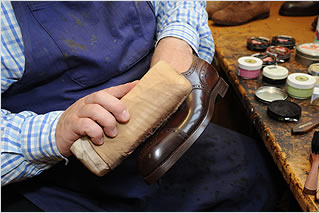 |
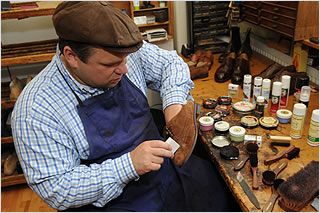 |
| A nylon stocking slipped over a polishing brush improves the polishing effect. |
Full-grain leather is cleaned with a velours rubber gum |
| |
|
|
Himer & Himer shoes care tips
1. Always buy good shoewear, otherwise all shoeshine is useless. Don‘t wait too long with repairs. It will be more expensive if the shoe has to be build up from the bottom.
2. Wear your shoes just for one day and let them rest for two. If they are put on shoetrees made of wood. The shoes have to be warm, otherwise the shoetree overstretches the shoes abruptly and small tears occur on the upper.
3. The shoetrees are supposed to be made of unvarnished wood, otherwise they can‘t absorb the sweat and so the leather is able to breath correctly. The perfect fit of the shoetree is absolutely necessary. We will give good advise with pleasure as we can offer several different shoetrees in our store.
|
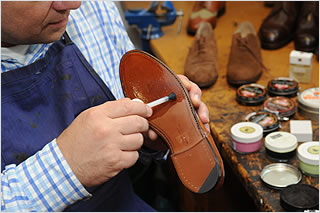 |
| Leather soles are made water resistant with a special sole leather oil. Be careful, don’t treat the stitching with the oil! The adherence could come off. |
| |
4. Never keep shoes into an airtight wardrobe – there ought to be vent slots.
5. Don‘t spare your shoes too much, leather stands contact with water for a short time, even needs it. It‘s been proofed long-since, that the water-resistant leather soles of the tannery Rendenbach, which we use solely, get even more resistent through walks in the rain. For every „care case“ the right care product! Remove the shoelaces before starting the shoe care! The upper is at first supposed to be cleaned from dust and old shoepolish crust with a liquid leather cleaner. So it can breathe.
|
 |
Chewing gum on the sole is being
iced with an ice spray. |
| |
|
|
Careful with saddle soap, it doesn‘t work well with all leathers. And it implicates a strong lipid replenishing, so the leather can be overgreased and the pores can‘t absorb the shoepolish, which gives the shoe ist color..
|
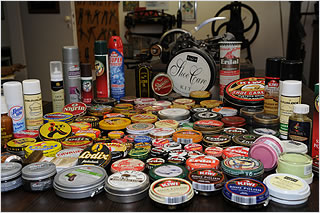 |
| |
|
| 6. For smooth leather there are basically two possibilities of color refreshment. Either with a wax paste or a fluid shoepolish. You have to decide whether the is supposed to be high gloss or mat finished. Fluid shoepolish is absorbed quickly from the pores and gives the leather a semigloss surface, whereas wax penetrate so deep into the pores. It remains more on the surface and causes a high gloss effect. (Note: The longer shoepolish or wax are being absorbed, the more polishing work is necessary, but the better is the gloss effect. ) |
| |
|
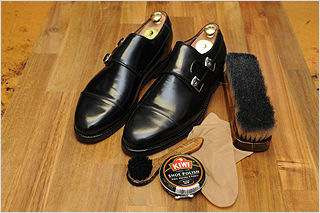 |
7. The application of the paste or the polish is done best with a special coating brush. After an hour rub it in with a polishing cloth and remove the remaining polish. For polishing we recommend a big horse hair brush. During the polishing spit from time to time onto the upper. That‘s good in order to get a better gloss effect, especially when using a paste which contains wax. Spit is better than water. The enzyms in it give the leather a better care effect. |
| |
|
|
8. For patent leather only use patent leather care. Anything else causes more damage than it helps.
9. Welt and sole The leather welt also needs care when the shoes are polished and waxed. Otherwise it dries out and cracks. There are special welt coating brushes, which take the care product to where its needed.
10. If the shoes are totally drenched, they are stuffed with pieces of newspaper and replaced when saturated. The so-called „snow edges“, which appear not only because of road salt but also arise from the tan salts and the minerals of the leather, are best dashed away with warm waterlogged cloth. We recommend to sluice the whole shoe with the wet cloth. The leather sole can be treated from time to time with lether oil – but don‘t apply it to the seam and the edges. The oil could dissolve the glue. By the way, the best way to kill your shoes is a warm radiator!
|
| |
|
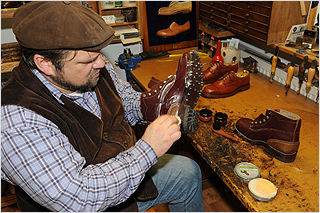 |
11. Full-grain leather has to be pruned of dust with a small brass brush before it is proofed. Persistent stains are best treated with a velour rubber gum. If snow edges or persistent dirt deface the suede shoes, they have to be cleanded with a big, coarse brush and then completely plunged into water. Finally they are washed with curd soap and hung up for drying. When they are dry, they are brushed with a brass brush in one direction and proofed. (Important: Only use high-quality brass brushes) |
| |
|
|
12. When traveling you ought to grant your shoes just first-class comfort. Sandwiched for three days in a suitcase, possibly in a plastic bag, destroy months of accurate shoe care. Traveling shoes have to be put into little flannel sacks. If shoe trees boost the excess baggage charge, you only take one pair with you and get by with pieces of newspaper for the other pairs.
13. A shoehorn is not just vestibule decoration, it‘s real shoe care. Is none available take a soup spoon without being ashamed. It can be cleaned – but if you have an accordeon heel nothing helps anymore!
|
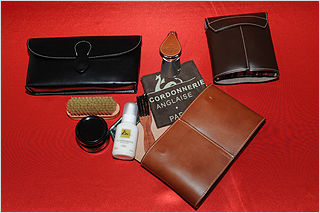 |
| |
|
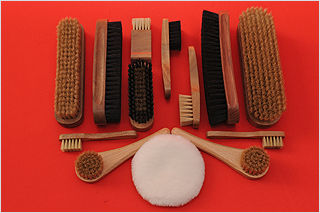 |
Himer’s tips for removing stains on leather
Liquids, food and fats have to be removed immediately with a napkin, a paper towel or toilet paper. If necessary, wipe large with water.
In some cases the emergence of stains can be prevented if one reacts quick-thinking: Blood for example has to be wiped with cold water, red wine has to be neutralized with white wine before it’s being absorbed with a napkin and salt has to be strewed on the stain.
|
| |
|
|
Wet stains have to be absorbed before other steps are taken (use blotting paper, coffee filters, napkins, tissues, kitchen paper and salt). The more liquid is being absorbed, the better it is.
Do not rub, just absorb!
Otherwise the substance, which has to be removed, could be pressed into the material or the stain is just spread.
Rule no. 1:
After the stain has disappeared the leather has to be provided with fresh nutrients. Please consult an expert before any experiments are performed. |
 |
| |
|